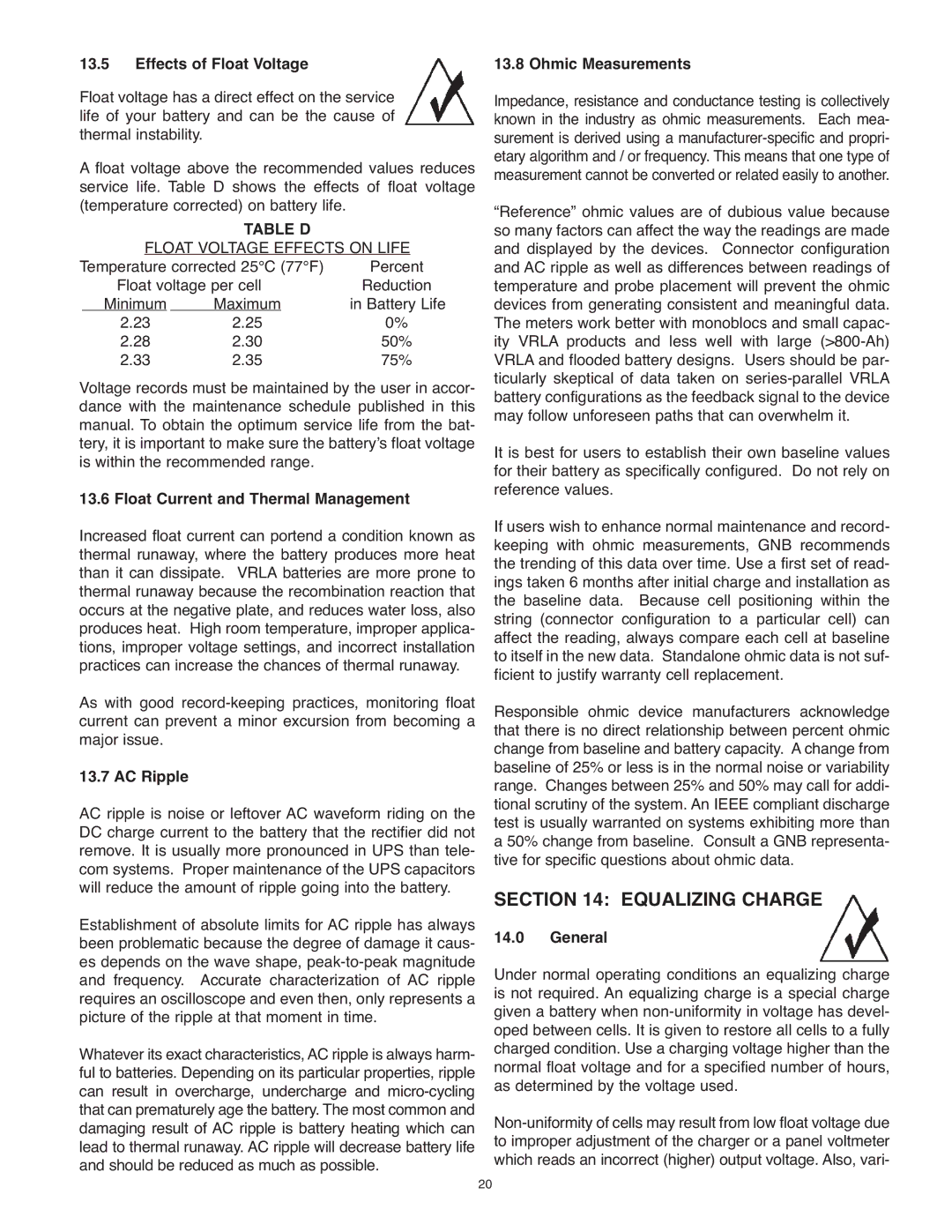
13.5 Effects of Float Voltage |
| |
Float voltage has a direct effect on the service | ||
life of your battery and can be the cause of | ||
thermal instability. |
|
|
A float voltage above the recommended values reduces | ||
service life. Table D shows the effects of float voltage | ||
(temperature corrected) on battery life. |
| |
| TABLE D |
|
FLOAT VOLTAGE EFFECTS ON LIFE | ||
Temperature corrected 25°C (77°F) | Percent | |
Float voltage per cell | Reduction | |
Minimum | Maximum | in Battery Life |
2.23 | 2.25 | 0% |
2.28 | 2.30 | 50% |
2.33 | 2.35 | 75% |
Voltage records must be maintained by the user in accor- dance with the maintenance schedule published in this manual. To obtain the optimum service life from the bat- tery, it is important to make sure the batteryʼs float voltage is within the recommended range.
13.6 Float Current and Thermal Management Increased float current can portend a condition known as thermal runaway, where the battery produces more heat than it can dissipate. VRLA batteries are more prone to thermal runaway because the recombination reaction that occurs at the negative plate, and reduces water loss, also produces heat. High room temperature, improper applica- tions, improper voltage settings, and incorrect installation practices can increase the chances of thermal runaway. As with good
13.7 AC Ripple
AC ripple is noise or leftover AC waveform riding on the DC charge current to the battery that the rectifier did not remove. It is usually more pronounced in UPS than tele- com systems. Proper maintenance of the UPS capacitors will reduce the amount of ripple going into the battery.
Establishment of absolute limits for AC ripple has always been problematic because the degree of damage it caus- es depends on the wave shape,
Whatever its exact characteristics, AC ripple is always harm- ful to batteries. Depending on its particular properties, ripple can result in overcharge, undercharge and
13.8 Ohmic Measurements
Impedance, resistance and conductance testing is collectively known in the industry as ohmic measurements. Each mea- surement is derived using a
It is best for users to establish their own baseline values for their battery as specifically configured. Do not rely on reference values.
If users wish to enhance normal maintenance and record- keeping with ohmic measurements, GNB recommends the trending of this data over time. Use a first set of read- ings taken 6 months after initial charge and installation as the baseline data. Because cell positioning within the string (connector configuration to a particular cell) can affect the reading, always compare each cell at baseline to itself in the new data. Standalone ohmic data is not suf- ficient to justify warranty cell replacement.
Responsible ohmic device manufacturers acknowledge that there is no direct relationship between percent ohmic change from baseline and battery capacity. A change from baseline of 25% or less is in the normal noise or variability range. Changes between 25% and 50% may call for addi- tional scrutiny of the system. An IEEE compliant discharge test is usually warranted on systems exhibiting more than a 50% change from baseline. Consult a GNB representa- tive for specific questions about ohmic data.
SECTION 14: EQUALIZING CHARGE
14.0 General
Under normal operating conditions an equalizing charge is not required. An equalizing charge is a special charge given a battery when
20 which reads an incorrect (higher) output voltage. Also, vari-
